Contents
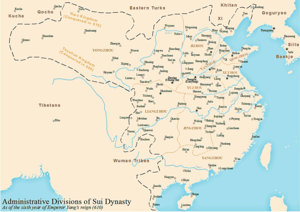
This is a timeline of the Sui dynasty.

This is a timeline of the Sui dynasty.
| Year | Date | Event |
|---|---|---|
| 581 | 4 March | Yang Jian (Emperor Wen of Sui) replaces the Northern Zhou with the Sui dynasty [1] |
| 582 | Emperor Xuan of Chen dies and is succeeded by Chen Shubao [1] | |
| 583 | Emperor Wen of Sui moves into Daxingcheng (Xi'an, Shaanxi) and abolishes the commanderies while promulgating the Kaihuang Code [1] | |
| 584 | Digs the Guangtong Canal [2] | |
| 587 | Annexes Western Liang [1] | |
| 588 | Launches expedition against the Chen dynasty [1] | |
| 589 | Takes Jiankang and annexes the Chen dynasty; so ends the Northern and Southern dynasties [1] |
| Year | Date | Event |
|---|---|---|
| 590 | Yang Su crushes rebellions in annexed Chen territory [1] | |
| 592 | Emperor Wen of Sui sends out commissioners to implement the equal-field system throughout the realm [1] | |
| 593 | The Cuanman rebel in Yunnan [3] | |
| The Renshou Palace is built west of the capital [1] | ||
| The writing of National Histories by private individuals is banned [1] | ||
| 594 | Severe drought hits Guanzhong but Emperor Wen of Sui leads its people to Luoyang for food [1] | |
| 595 | Construction of the Anji Bridge begins [4] | |
| 597 | Tiantai sect founder Zhiyi dies [1] | |
| A campaign is launched against the Cuanman [3] | ||
| 598 | Goguryeo–Sui War : First expedition against Goguryeo fails [1] | |
| 599 | Chief minister Gao Jiong deprived of power [1] | |
| Yami Qaghan flees to the Sui dynasty [1] |
| Year | Date | Event |
|---|---|---|
| 601 | 90,000 Turks submit [1] | |
| 602 | Sui–Former Lý War : Sui forces under Liu Fang annex the Early Lý dynasty [5] | |
| Sui destroys the Cuanman [3] | ||
| 603 | Yami Qaghan takes over Tulan Qaghan's lands after he dies [1] | |
| 604 | 13 August | Emperor Wen of Sui dies and is succeeded by Yang Guang (Emperor Yang of Sui) [6] |
| Yang Liang rebels in Bingzhou but is defeated [6] | ||
| 605 | Sui forces under Liu Fang invade Champa and sack its capital [7] | |
| Construction of a new Luoyang and the Tongji Canal begin [6] | ||
| The Anji Bridge is completed [4] | ||
| Emperor Yang of Sui visits Jiangdu [6] | ||
| 606 | Luoyang is completed and Emperor Yang of Sui returns from Jiangdu [6] | |
| 607 | Yami Qaghan visits Emperor Yang of Sui in Luoyang [6] | |
| Gao Jiong is killed [6] | ||
| Ono no Imoko visits China [6] | ||
| The Sui dynasty sends expeditions to an island known as Liuqiu, which may or may not be Taiwan, but is probably Ryukyu [8] | ||
| 608 | The Yongji Canal is dug [6] | |
| Pei Shiqing accompanies Ono no Imoko back to Japan [6] | ||
| 609 | Emperor Yang of Sui visits Zhangye [6] |
| Year | Date | Event |
|---|---|---|
| 610 | Emperor Yang of Sui visits Jiangdu [6] | |
| Construction of the Jiangnan Canal begins [6] | ||
| 611 | Goguryeo–Sui War : Emperor Yang of Sui arrives at Zhuojun to prepare for war with Goguryeo [6] | |
| Wang Bo (王薄) rebels in Changbaishan (Zouping, Shandong) [6] | ||
| 612 | Goguryeo–Sui War : The invasion of Goguryeo fails [6] | |
| 613 | Goguryeo–Sui War : Emperor Yang of Sui is forced to withdraw from the second invasion due to Yang Xuangan's rebellion in Liyang [6] | |
| Du Fuwei and Fu Gongshi rebel [9] | ||
| 614 | Goguryeo–Sui War : Another invasion fails [6] | |
| 615 | Shibi Khan lays siege to Yanmen [6] | |
| 616 | Emperor Yang of Sui leaves for Jiangdu [6] | |
| 617 | Li Mi and Zhai Rang rebel, seizing Luokou Granary and Huiluo Granary [6] | |
| Li Yuan, regent of Taiyuan, rebels and takes Daxingcheng [6] | ||
| 618 | 11 April | Emperor Yang of Sui is killed by strangulation in a coup led by his general Yuwen Huaji in Jiangdu [10] |
| 12 June | Li Yuan (Tang Gaozu - note that Tang emperor naming convention uses the posthumous Temple Name) deposes Emperor Gong of Sui and founds the Tang dynasty; so ends the Sui dynasty [10] |

Nanzhao was a dynastic kingdom that flourished in what is now southern China and northern Southeast Asia during the 8th and 9th centuries. It was centered on present-day Yunnan in China.

This is a timeline of the Three Kingdoms period (220–280) of Chinese history. In a strict academic sense, the Three Kingdoms period refers to the interval between the founding of the state of Cao Wei (220–266) in 220 and the conquest of the state of Eastern Wu (229–280) by the Western Jin dynasty (265–316) in 280. However, many Chinese historians and laymen extend the starting point of this period back to the Yellow Turban Rebellion that took place in 184 during the late Eastern Han Dynasty (25–220).
The Protectorate General to Pacify the North or Grand Protectorate General to Pacify the North (647–784) was a Chinese military government established by the Tang dynasty in 647 to pacify the former territory of Xueyantuo, which extended from Lake Baikal to the north, the Gobi Desert to the south, the Khingan Mountains to the east, and the Altay Mountains to the west. It controlled the Mongolian Plateau from 647 to 682.

The Four Garrisons of Anxi were Chinese military garrisons installed by the Tang dynasty between 648 and 658. They were stationed at the Indo-European city-states of Qiuci (Kucha), Yutian (Hotan), Shule (Kashgar) and Yanqi (Karashahr). The Protectorate General to Pacify the West was headquartered in Qiuci.

This is a timeline of the Tang dynasty, which covers a period of roughly 289 years, from 618, when the dynasty was founded, to 907, when the last Tang emperor was deposed by the warlord Zhu Wen, who established the Later Liang dynasty, inaugurating the period of Five Dynasties and Ten Kingdoms. Information on areas and events relevant to the Tang dynasty such as the Wu interregnum, when Wu Zetian established her own Zhou dynasty, and other realms such as the Sui dynasty, Tibetan Empire, Three Kingdoms of Korea, Nanzhao, Japan and steppe nomads are also included where necessary.
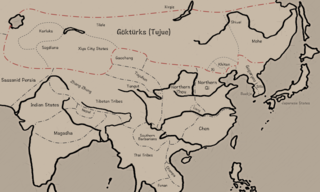
This is a timeline of the Göktürks from the origins of the Turkic Khaganate to the end of the Second Turkic Khaganate.
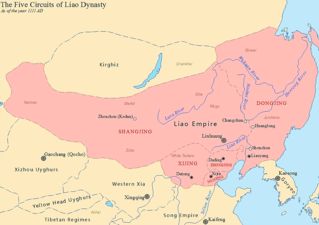
This is a timeline of the history of the Khitans. The Khitans were a nomadic people in northeastern Asia related to the Xianbei. Following the collapse of the Tang dynasty, they established the Liao dynasty in 916, encompassing parts of modern-day northern China, Mongolia, and North Korea. The Liao dynasty was eventually conquered by the Jin dynasty in 1125. Remnants of the Liao court led by Yelü Dashi fled westward to Central Asia where they established the Western Liao dynasty. In 1211, the Western Liao throne was usurped by a Naiman called Kuchlug. In 1218, the Mongol Empire defeated and conquered the Western Liao dynasty.
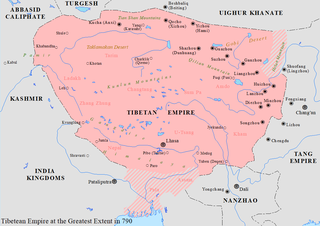
This is a timeline of the Tibetan Empire from 6th to 9th century.

This is a timeline of the Karluks. The Kara-Khanid Khanate is also included, however it is disputed whether the Karluks or Yagmas were the dominant group within the khanate.

This is a timeline of the Jurchens.
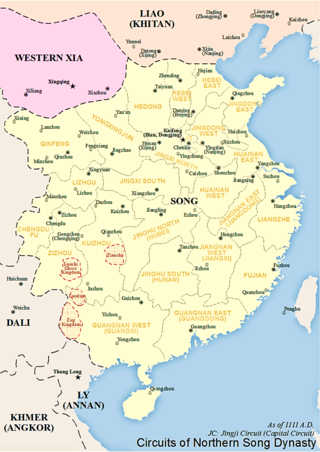
This is a timeline of the Song dynasty (960–1279). The Song dynasty was founded by Zhao Kuangyin, posthumously known as Emperor Taizu of Song, who ended the period of division known as the Five Dynasties and Ten Kingdoms period. The Song dynasty is commonly separated into two historical periods, the Northern Song (960–1127) and the Southern Song (1127–1279), divided by the loss of the north to the Jurchen Jin dynasty (1115–1234). In 1279, the Mongol Yuan dynasty conquered the Song.

This is a timeline of the Five Dynasties and Ten Kingdoms (907–979), which followed the collapse of the Tang dynasty in 907 AD. The Five Dynasties refer to the succession of dynasties which ruled northern China following the Tang collapse while the Ten Kingdoms, with the exception of Northern Han, ruled in southern China. This era of division ended in 979 AD with the rise of the Song dynasty under Emperor Taizu of Song, although the Song would never reconquer the northern territory lost to the Khitans, collectively known as the Sixteen Prefectures.
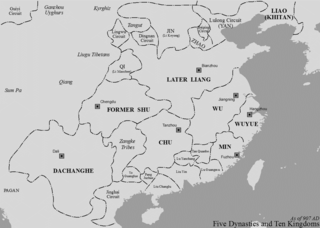
This is a timeline of the Tangut people and Western Xia.

This is a timeline of the Ming dynasty (1368–1644) from the rise of the Hongwu Emperor to the rise and establishment of the Qing dynasty.

Yunnan under Ming rule saw the continuation of the tusi system instituted during the Yuan dynasty, increasing centralization, and Han migration into Yunnan.
This is a timeline of Vietnamese history under Chinese rule from the 3rd century BC to 905.
This is a timeline of Yunnan and Guizhou.

This is a timeline of the Xiongnu, a nomadic people that dominated the ancient eastern Eurasian steppes from 209 BC to 89 AD. The Xiongnu settled down in northern China during the late 3rd century AD following the Three Kingdoms period, and founded several states lasting until the Northern Liang was conquered by the Xianbei Northern Wei in 439 AD.

This is a timeline of the Xinjiang under the rule of the Qing dynasty.

This is a timeline of the Era of Fragmentation, the period of Tibetan history lasting from the death of the Tibetan Empire's last emperor, Langdarma, in 842 until Drogön Chögyal Phagpa gained control over the three provinces of Tibet in 1253 under Mongol rule.